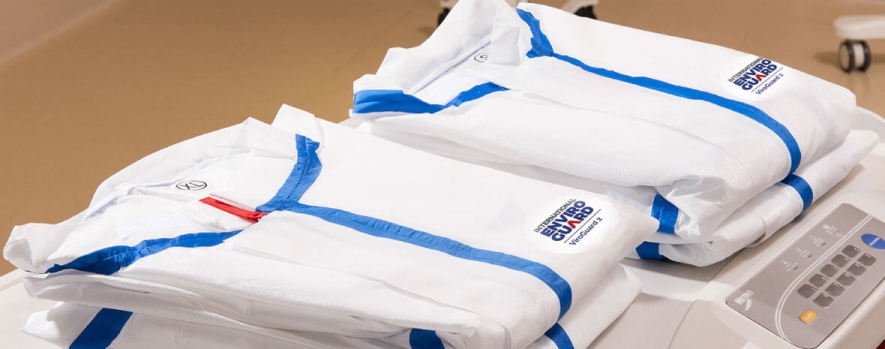
In 2014, an Ebola outbreak hit the news cycle by storm. By the time the outbreak was contained in the spring of 2016, a total of 11,325 people had died in six countries, including one person in the United States. Additionally, there were a total of 15,261 confirmed cases spanning ten countries.
In response to the crisis, the CDC updated their personal protective equipment (PPE) guidelines for healthcare workers tasked with managing patients with confirmed or suspected diagnoses of the virus. These updates were important for optimizing the ability of healthcare workers to effectively care for patients without unnecessarily exposing themselves (and the community-at-large) to the disease.
Today, a new Ebola outbreak has been reported in the Democratic Republic of Congo (DRC). As of January 7th, 2019, the DRC's Ministry of Health has reported 577 confirmed cases and 48 probable, for a total of 625. In light of this recent news, revisiting the current PPE guidelines for Ebola workers is warranted.
What is Ebola?
Ebola is a type of virus (from the genus Ebolavirus) which can lead to a deadly condition known as Ebola hemorrhagic fever. It affect primates, both human and non-human, including monkeys, gorillas, and chimpanzees.
While the exact source of the Ebola virus isn't known, bats are the most likely point of origin. The virus was first discovered in the DRC back in the mid-1970s, and has since led to occasional outbreaks originating in various African countries, including the DRC, Sierra Leone, Liberia, and Guinea.
As the name implies, Ebola hemorrhagic fever can lead to fever, severe internal bleeding, and organ failure. Signs and symptoms (which can present 2-21 days after initial exposure) include headaches, muscle pain, weakness, abdominal pain, vomiting, diarrhea, fatigue, fever, and unexplained bleeding or bruising. Sadly, Ebola fever can be fatal.
It is also highly contagious. The virus can be spread directly or indirectly—that is, by coming in contact with the blood or bodily fluids of a person already infected with the virus, or by touching objects (such as medical equipment, toilets, and door knobs) which have been contaminated by such fluids.
These infected fluids can easily enter a person's body via cuts in the skin or mucous membranes in the nose, mouth, and eyes. For this reason, prevention of cross-contamination and infection begins with protecting these potential modes of transmission.
PPE Recommendations for Healthcare Workers
For healthcare professionals and other workers on the front line against Ebola outbreaks, appropriate personal protective equipment (PPE) is of utmost important—not only for personal protection, but for the prevention of further infectious disease spreading.
PPE Type/Design
According to latest updates from the CDC and the World Health Organization (WHO), PPE guidelines for healthcare workers assisting with the management of Ebola can be summarized as follows:
- PPE must fully cover the skin and clothing, as well as prevent exposure to the virus via the eyes, nose or mouth.
- PPE attire must be either a) either a disposable gown plus apron, or b) a disposable coverall and apron. Because Ebola is found in bodily fluids of infected people, the disposable PPE apparel should be resistant to penetration by blood, bodily fluids, and blood-borne pathogens.
- In addition to disposable gowns/coveralls and aprons, all healthcare Ebola workers should wear a head and neck cover, double nitrile gloves, waterproof boots, fluid-resistant masks and/or respirators (depending on procedures being performed), and face shields and/or goggles.
PPE Protocol
In addition to the proper type of PPE, the CDC rightly suggests that no PPE—no matter how impervious it is to infectious agents—will be effective for infection control if appropriate protocols are not in place.
Such protocols—including worker education and donning/doffing techniques—must be in line with requirements from the CDC and Occupational Health and Safety ACT (OSHA). For more on these requirements, employers and organizations can refer to OSHA's stance on Bloodborne Pathogens, Respiratory Protection, and General Requirements for PPE.
Healthcare Worker Comfort
Of course, any and all PPE must be suitable for worker efficiency, productivity, comfort, and safety—protective apparel must not impede a healthcare worker's ability to perform her occupational duties nor dramatically increase her risk for heat-related stress.
To improve workplace flow, patient care, and personnel protection, PPE also needs to be easy to don, doff, and dispose of. This is why breathable, lightweight, yet liquid-resistant material is the preferred material for the CDC and WHO.
Ebola-Appropriate PPE From International Enviroguard
The above recommendations from the CDC and WHO have been made based on the best available scientific evidence regarding disease prevention and infection control. To accommodate such recommendations, International Enviroguard proudly offers our patented ViroGuard® 2. We believe ViroGuard® 2 effectively meets the rigorous and important standards set by the American Society for Testing and Materials (ASTM). These standards include ASTM F1670(blood) and ASTM F1671 (blood-borne pathogens).
ViroGuard® 2 garments are suitable for healthcare workers caring for patients who either:
- "Wet": diagnostically confirmed and clinically unstable, who are presenting with bleeding, vomiting, and diarrhea, or
- "Dry": considered clinically stable and a person under investigation (PUI), who are presenting without bleeding, vomiting, or diarrhea
The flexible fabric and seams on ViroGuard® 2 garments enhance worker protection without compromising on comfort, dexterity, nor ease of donning and doffing procedures. Additional features of our ViroGuard® 2 garments include:
- Thumb and finger loops to prevent sleeves from unwanted sleeve movement
- Large red zipper pulls that are easy to see and manipulate when wearing double gloves
- Adjustable Velcro closures at the collar for improved neck seal
- Double-sided tape at the wrists to keep gloves in place
We're proud to share that ViroGuard® 2 is one of the preferred PPE choices for Regional Ebola and Special Pathogen Treatment Centers (RESPTCs), as well as several top assessment facilities.
Will your company be involved in responses to current or future Ebola outbreaks? Click here to learn more about International Enviroguard and how we're doing our part to protect healthcare workers and the community at large against infectious diseases.